 Remnants
of a female ivory statue, perhaps of Artemis, wearing a gold diadem and
executed in the
chryselephantine technique which used gold (chyrs) and ivory (elephantine).
Ionian work of the 6th century BCE. Remnants
of a female ivory statue, perhaps of Artemis, wearing a gold diadem and
executed in the
chryselephantine technique which used gold (chyrs) and ivory (elephantine).
Ionian work of the 6th century BCE. |
|
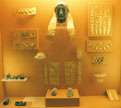 Remnants
of a male statue of fire-blackened ivory representing Apollo. The eyes are
inlaid and the hair is of silver-gilt lamina. The two tresses of hair in front
are of gold. A splendid offering by an Ionian city of the 6th century BCE. Remnants
of a male statue of fire-blackened ivory representing Apollo. The eyes are
inlaid and the hair is of silver-gilt lamina. The two tresses of hair in front
are of gold. A splendid offering by an Ionian city of the 6th century BCE. |
|
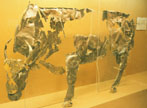 Fragments
of an Ionian silver-plated bull of the mid 6th century BCE, the largest
example from antiquity of a statue made out of precious metal. Fragments
of an Ionian silver-plated bull of the mid 6th century BCE, the largest
example from antiquity of a statue made out of precious metal. |
|
|
|
|
|
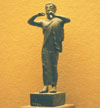 Bronze
statuette of a piper in a chiton and himation. Having covered his mouth
with the leather headbands to support the instrument, he is playing the
double pipes. The case for the pipes hang over his left shoulder. A humble
ex-voto, probably from the winner of a pipe competition, from a Corinthian
workshop c. 500 BCE. Bronze
statuette of a piper in a chiton and himation. Having covered his mouth
with the leather headbands to support the instrument, he is playing the
double pipes. The case for the pipes hang over his left shoulder. A humble
ex-voto, probably from the winner of a pipe competition, from a Corinthian
workshop c. 500 BCE. |
|
 Bronze
statue. Bronze
statue. |
|
 Archaic
kouroi
statues representing Kleobis and Biton, stylized representations of young
brothers who were given the gift of eternal sleep by Hera, after they
yoked themselves to a chariot to carry their mother to Hera's temple and
of whom it was said, "those whom the gods love die young." They are the work of
the Argive sculptor Polymedes, c. 590 BCE. Archaic
kouroi
statues representing Kleobis and Biton, stylized representations of young
brothers who were given the gift of eternal sleep by Hera, after they
yoked themselves to a chariot to carry their mother to Hera's temple and
of whom it was said, "those whom the gods love die young." They are the work of
the Argive sculptor Polymedes, c. 590 BCE. |
|
|
|
|
|
 The
Naxian Sphinx, c. 570-560 BCE, presented by the wealthy citizens of
Naxos. It stands 2.3 m (7.5 ft) high, and once had its place atop a column
reaching over 10 m (33 ft) in height. The
Naxian Sphinx, c. 570-560 BCE, presented by the wealthy citizens of
Naxos. It stands 2.3 m (7.5 ft) high, and once had its place atop a column
reaching over 10 m (33 ft) in height. |
|
 One
of the two Caryatids supporting the cornice of the Treasury of the
Siphnians. The holes around the head were for attaching a metal crown,
perhaps gilded. Her polo (bonnet), only the back part preserved, was ornamented by
a very eroded relief of Sileni and Maenads dancing. Circa 525 BCE. One
of the two Caryatids supporting the cornice of the Treasury of the
Siphnians. The holes around the head were for attaching a metal crown,
perhaps gilded. Her polo (bonnet), only the back part preserved, was ornamented by
a very eroded relief of Sileni and Maenads dancing. Circa 525 BCE. |
|
 Marble
statue of a female dancer. Marble
statue of a female dancer. |
|
|
|
|
|
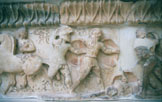 Detail
of the right section of the east frieze from the Treasury of the Siphnians.
It depicts a fierce battle between fully armed Greeks (right) and Trojans
over the prostrate body of a fallen hero. It is a wonderful specimen
of mature Archaic art dated to 525 BCE. Detail
of the right section of the east frieze from the Treasury of the Siphnians.
It depicts a fierce battle between fully armed Greeks (right) and Trojans
over the prostrate body of a fallen hero. It is a wonderful specimen
of mature Archaic art dated to 525 BCE. |
|
 Marble
pediment. Marble
pediment. |
|
 Bronze
statue of a charioteer, originally belonging to a larger group which
represented a chariot drawn by four horses. It was dedicated to Apollo by
the Syracusan
Polyzalos, the brother of the tyrants Gelon and Hieron, in 478 BCE to commemorate
a chariot victory at
the Pythian Games. This incomparable statue is a representative example of
the 'severe' Attic style, certainly the work of a major artist. Bronze
statue of a charioteer, originally belonging to a larger group which
represented a chariot drawn by four horses. It was dedicated to Apollo by
the Syracusan
Polyzalos, the brother of the tyrants Gelon and Hieron, in 478 BCE to commemorate
a chariot victory at
the Pythian Games. This incomparable statue is a representative example of
the 'severe' Attic style, certainly the work of a major artist. |
|
|
|
|
|
 The
Column of the Dancers, carved from Pentelic marble, features statues of three young women forming the upper part
of a column encircled with acanthus leaves. The figures are dancing, all
wear a short, transparent chiton and bear a basket-like polos on their
heads. The column is believed to have supported a tripod of the kind sat
on by the Pythia as she went into her oracular trances. The girls are
thought to be celebrating the feast of the god Dionysus who also resided
in the sanctuary. His presence was honored in the winter months when
Apollo was resting or away elsewhere. The column is an Athenian
offering to the sanctuary dated to c. 380 BCE. The
Column of the Dancers, carved from Pentelic marble, features statues of three young women forming the upper part
of a column encircled with acanthus leaves. The figures are dancing, all
wear a short, transparent chiton and bear a basket-like polos on their
heads. The column is believed to have supported a tripod of the kind sat
on by the Pythia as she went into her oracular trances. The girls are
thought to be celebrating the feast of the god Dionysus who also resided
in the sanctuary. His presence was honored in the winter months when
Apollo was resting or away elsewhere. The column is an Athenian
offering to the sanctuary dated to c. 380 BCE. |
|
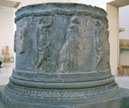 Marble
sheathing from a circular altar found in the Sanctuary of Athena with a
relief of women adorning the garland below the rim of the altar with
scarves. Relief work characteristic of the Late Hellenistic period, mid
1st century BCE. Marble
sheathing from a circular altar found in the Sanctuary of Athena with a
relief of women adorning the garland below the rim of the altar with
scarves. Relief work characteristic of the Late Hellenistic period, mid
1st century BCE. |
|
 Bronze tripod. Bronze tripod. |
|
|
|
|
|
 Just
inside the entrance to the museum stands the marble Omphalos, or navel
stone,
covered with a woolly net pattern carved in relief. This is a Hellenistic
or Roman copy of the stone that was believed to have marked the place
above which Zeus' eagles met establishing the sanctuary as the center of
the world. Just
inside the entrance to the museum stands the marble Omphalos, or navel
stone,
covered with a woolly net pattern carved in relief. This is a Hellenistic
or Roman copy of the stone that was believed to have marked the place
above which Zeus' eagles met establishing the sanctuary as the center of
the world. |
|
 Marble
statue of Antinous, a youth famous for his beauty, and the favorite of
emperor Hadrian. It is one of the best of the surviving statues of the
dreamy youth. Its debt to ancient Greece originals is obvious, but it
differs from them radically. Antinous' body is soft, very different from
the taut, well-knit bodies of the Greek youths hardened by exercise in the
wrestling schools. The head has originality, with its profuse hair
separated into small curls that frame the boy's pretty features. A
didactic work of Roman classicalism dated to the Hadrian period (130 - 138
CE). Marble
statue of Antinous, a youth famous for his beauty, and the favorite of
emperor Hadrian. It is one of the best of the surviving statues of the
dreamy youth. Its debt to ancient Greece originals is obvious, but it
differs from them radically. Antinous' body is soft, very different from
the taut, well-knit bodies of the Greek youths hardened by exercise in the
wrestling schools. The head has originality, with its profuse hair
separated into small curls that frame the boy's pretty features. A
didactic work of Roman classicalism dated to the Hadrian period (130 - 138
CE). |
|
 Marble friezes Marble friezes |
|
|
|
|
|